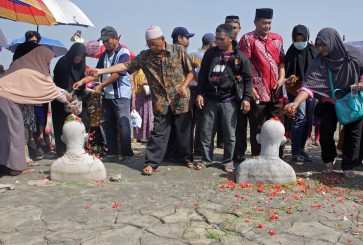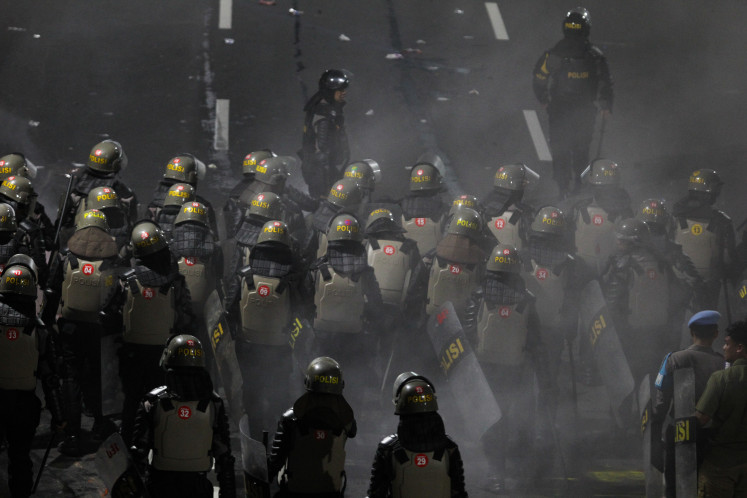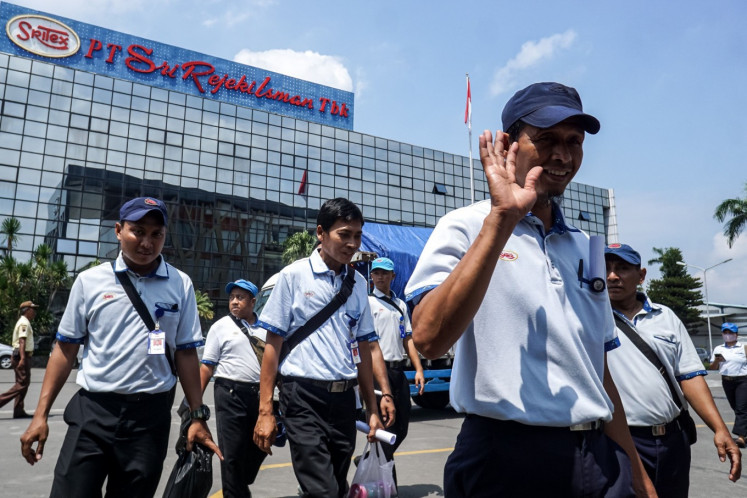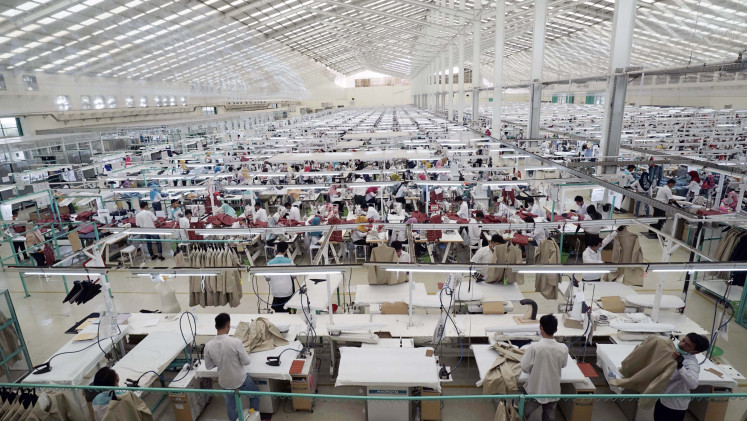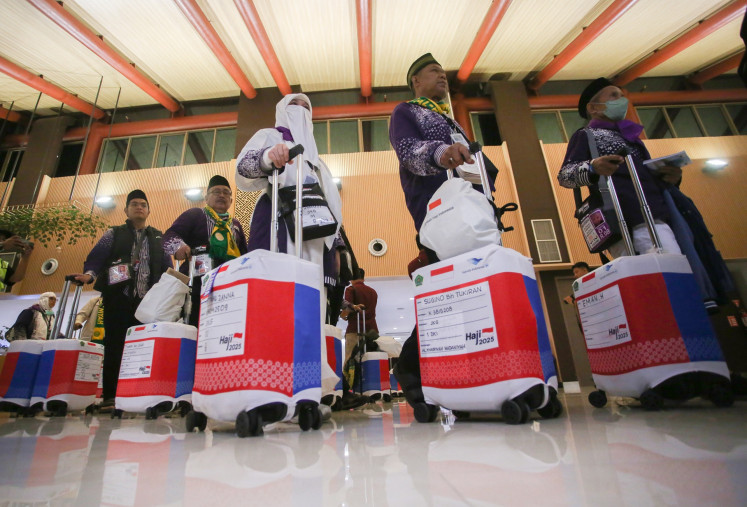E-commerce boosts the logistics sector in Indonesia
After China, Indonesia is seen as the next big thing in Asia’s e-commerce market and the logistics sector should thrive from it.
Change text size
Gift Premium Articles
to Anyone
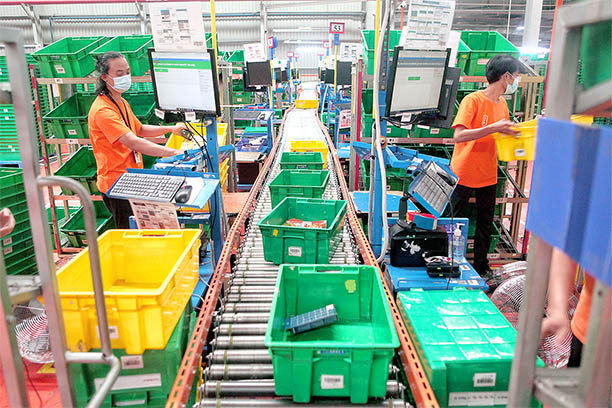 Sales up: Employees sort out goods at a Lazada warehouse in Cimanggis, West Java, on Thursday. During Lazada’s three-day national online shopping (Garbolnas) held on Dec. 12-14, the online retail platform saw a 100 percent increase in sales from 2019. Bank Indonesia (BI) recorded Rp 180.74 trillion in e-commerce transactions as of September, lower than that in 2019 at Rp 201 trillion. (JP/Seto Wardhana)
Sales up: Employees sort out goods at a Lazada warehouse in Cimanggis, West Java, on Thursday. During Lazada’s three-day national online shopping (Garbolnas) held on Dec. 12-14, the online retail platform saw a 100 percent increase in sales from 2019. Bank Indonesia (BI) recorded Rp 180.74 trillion in e-commerce transactions as of September, lower than that in 2019 at Rp 201 trillion. (JP/Seto Wardhana)
S
ince its first inception, e-commerce has taken the local retail industry by storm. Boosted by the rapid development of the internet and mobile technology, the sector has seen tremendous growth over the past decade.
Generally, e-commerce requires much more logistics space compared to traditional retail as most retailers’ inventory is stored in the warehouse, rather than spaced out between warehouse and stores. In addition, online retailers tend to have a larger array of products in their inventory, thus requiring relatively bigger and more comprehensive storage that can accommodate and easily adapt to the changing business trends.
Despite the tremendous growth of e-commerce, the current supply-chain ecosystem in Indonesia is still poor and the sector lacks a number of key factors to support the ongoing growth. A World Bank report in 2018 mentioned that Indonesia’s Logistic Performance Index scored only 3.2 out of 6. Major issues that gave Indonesia the low ranking are lack of transportation infrastructure as well as red tape and complicated regulations, which result in a high-cost environment.
As such, the country’s logistics sector is still behind its neighboring countries, such as Malaysia, Thailand and Vietnam, in terms of the sector’s competitiveness and efficiencies. On the other hand, the highest-ranked country in ASEAN, Singapore, scored 4, with the highest score being timeliness and logistics competence.
Some aspects that need some adjustment are the efficiency of the clearance process and trade and transportation-related infrastructure. On the other hand, the timeliness of Indonesia’s logistics is on par with Vietnam, which is the third-best within the ASEAN region with a 3.67 score. Indonesia’s timeliness score showed an improvement from its score in 2016.
Nevertheless, the growth in Indonesia’s e-commerce continued to drive demand for better logistics space, which triggered more new developments. This led a number of local companies as well as foreign and international investors and developers to race in the competition to take the first-mover advantages.
Over the past few years, big institutional investors like GIC and regional logistics developers such as LOGOS and ESR have expanded to Indonesia. After China, Indonesia is seen as the next big thing in Asia’s e-commerce market, and the logistics sector should thrive from it.
The logistics process has a very detailed and organized structure to carry out various delivery and shipment-related operations. Every time a product is ordered, these systems are the ones that make sure that the customers receive the right product at the right time.
The development of technology and e-commerce has made a significant contribution to the improvement of the logistics process. And yet, without e-commerce, such a complicated logistics structure would never be implemented.
With the advancement of the logistics sector in Indonesia, new supply chain management providers started popping up to help online platforms organize their products. One particular type of provider is an e-commerce enabler that provides end-to-end business management for online retailers.
Several e-commerce companies like Lazada, Shopee and BukaLapak require a lot of warehouses, so the demand for warehouses will increase. As Indonesia’s internet penetration continued to increase, the value of e-commerce was estimated to rise by 88 percent between 2015 and 2019 to a total of US$21 billion.
Indonesia’s gross domestic product (GDP) in 2019 was estimated at $1.1 trillion. By expenditures, household spending made up 57 percent of the GDP, higher than 36 percent in Singapore and 50 percent in Thailand.
With the continuous growth of e-commerce, there will also be a demand for faster and more efficient logistics. The number of online shoppers will continue to grow and the logistic industry needs to find a way to make sure they fulfill the needs of 270 million people across the country.
Moreover, Indonesia has attracted many tech giants. Chinese e-commerce giant Alibaba, for example, entered Indonesia’s market through Tokopedia in 2020. Amazon has also shown an interest to expand its presence in Indonesia. Google & Temasek forecast that the number will quadruple from $21 billion in 2019 to up to $82 billion by 2025.
In response, many industrial property developers are racing to build integrated modern logistics properties to meet the need of e-commerce and FMCG companies. The market is likely to see a change in trends and investment preferences and more logistics developers will develop new modern and sophisticated facilities.
Altogether, the rise of e-commerce will push the logistics sector to speed up modernization, and with the uncertainty plaguing the global health issue, we are certain that within the next few years, Indonesia’s logistics property will have a vast change in terms of quality, infrastructure and capacity.
One of the most important features that an e-commerce company seeks in warehouses is advanced IT facilities that would speed up the handling and management of goods. High e-commerce utilization is closely associated with rapid technological improvement. In 2020, the advancement in technology pushed Indonesia’s internet penetration to 73 percent, compared to that of five years ago at 43 percent.
Moreover, it is predicted that in the next five years, internet penetration will grow up to 89 percent of the total population. As a result, Indonesia’s internet users have also grown tremendously over the past decade. According to 2018 statistics, around 65 percent of Indonesia’s population were active users, a 25 percent increase from 2010.
Supported by the rapid development of the internet in Indonesia, consumers can now fulfill their needs online. Being a frontrunner in the ASEAN region, Indonesia is expected to grow even further over the next five years and will likely strengthen its position as the core of Southeast Asia’s internet economy.
Among existing e-commerce platforms in Indonesia, the most popular medium with the highest number of users is the marketplace (B2C and C2C), followed by online travel and ride-hailing services. The highest transacted products in the local marketplace are fashion items and electronics. This segment has enjoyed steady growth.
Indonesia’s growth in the logistics sector is anticipated to accelerate faster than many other countries in the region on the back of a strong demographic and significant expansion in domestic retail and e-commerce.
However, the role of the government in supporting the logistics sector’s development is very important. As it involves distribution and the displacement of goods and services all over the country, the logistics sector depends quite a lot on infrastructure. As the authority, infrastructure development and policy from the government both on the national and provincial level play a pivotal role.
Furthermore, a good regulatory environment that can support the sector’s continuous dynamic is also required to make sure business operational and activity can grow steadily without many problems. Considering that the key driver of Indonesia’s economic growth is domestic consumption, which involves the distribution of goods and services, the government must be able to allocate and provide a strong focus to develop the local logistics sector.
***
Anton Sitorus is the head of department, Miranda Gultom is a manager and Vania Andini is a research analyst executive at PT Savills Consultants Indonesia. This article is abridged from Savills World Research Indonesia Briefing, December 2020.


